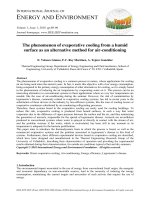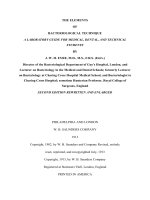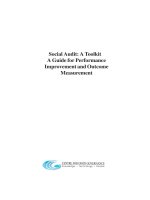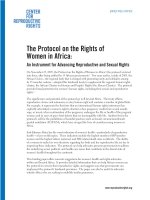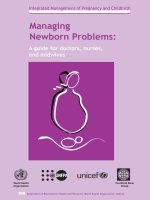- Trang chủ >>
- Khoa Học Tự Nhiên >>
- Vật lý
the handbook of international adoption medicine a guide for physicians parents and providers dec 2004
Bạn đang xem bản rút gọn của tài liệu. Xem và tải ngay bản đầy đủ của tài liệu tại đây (5.49 MB, 465 trang )
The Handbook of
International Adoption
Medicine:
A Guide for Physicians,
Parents, and Providers
Laurie C. Miller, MD
OXFORD UNIVERSITY PRESS
The Handbook of
International
Adoption Medicine
This page intentionally left blank
THE HANDBOOK OF
INTERNATIONAL
ADOPTION MEDICINE
A Guide for Physicians, Parents,
and Providers
Laurie C. Miller, MD
2005
Oxford New York
Auckland Bangkok Buenos Aires Cape Town Chennai
Dar es Salaam Delhi Hong Kong Istanbul Karachi Kolkata
Kuala Lumpur Madrid Melbourne Mexico City Mumbai
Nairobi São Paulo Shanghai Taipei Tokyo Toronto
Copyright © 2005 by Oxford University Press, Inc.
Published by Oxford University Press, Inc.
198 Madison Avenue, New York, New York, 10016
www.oup.com
Oxford is a registered trademark of Oxford University Press
All rights reserved. No part of this publication may be reproduced,
stored in a retrieval system, or transmitted, in any form or by any means,
electronic, mechanical, photocopying, recording, or otherwise,
without the prior permission of Oxford University Press.
Library of Congress Cataloging-in-Publication Data
Miller, Laurie C.
The handbook of international adoption medicine:
a guide for physicians, parents, and providers / Laurie C. Miller.
p. ; cm. Includes bibliographical references and index.
ISBN 0-19-517681-2; 0-19-514530-5 (pbk.)
1. Adopted children—Medical care—United States.
2. Adopted children—Health and hygiene—United States.
3. Adopted children—Diseases—United States.
4. Intercountry adoption.
5. Interracial adoption. I. Title.
DNLM: 1. Adoption. 2. Child Welfare. 3. Internationality.
4. Physician–Patient Relations.
WS 105.5.F2 M648h 2004 RJ101.2.M54 2004 618.92—dc22 2003069102
The science of medicine is a rapidly changing field. As new research and clinical expe-
rience broaden our knowledge, changes in treatment and drug therapy do occur. The
author and publisher of this work have checked with sources believed to be reliable in
their efforts to provide information that is accurate and complete, and in accordance
with the standards accepted at the time of publication. However, in light of the possi-
bility of human error or changes in the practice of medicine, neither the author, nor
the publisher, nor any other party who has been involved in the preparation or publi-
cation of this work, warrants that the information contained herein is in every respect
accurate or complete. Readers are encouraged to confirm the information contained
herein with other reliable sources and are strongly advised to check the product infor-
mation sheet provided by the pharmaceutical company for each drug they plan to
administer.
246897531
Printed in the United States of America
on acid-free paper
To all children of the world
who wait for families—
you are not forgotten
This page intentionally left blank
I
t has been an extraordinary pleasure of my
professional life to care for internationally
adopted children and their families. Every
pediatrician recognizes the surprising ability of
children to overcome illness and misfortune.
Nowhere in pediatrics is the incredible re-
silience of children so obvious as in interna-
tional adoption. Although it is disheartening to
see children live (or in some cases subsist) in or-
phanages, their transformation after adoption is
miraculous. Abandoned children who have suf-
fered multiple adversities change into happy,
healthy, thriving kids by the “simple” act of
adoption. The metamorphosis is sometimes vis-
ible within days.
The opportunity to work with prospective
adoptive parents has also been a privilege. Most
prospective parents deeply yearn for a child. It
is a joy to behold the fulfillment of these dreams
as a family is created or enlarged. The energy,
devotion, and love of pre- and post-adoptive
parents is unsurpassed.
When I visit orphanages, I often find
myself wishing I could write “orders” for each
child who lives there. I’d love to write a pre-
scription for each child to have a loving, atten-
tive family. No amount of medical care, educa-
tion, interventions, or special activities can
replace family love. For children from difficult
backgrounds, adoption is the perfect remedy.
The medical model sometimes overlooks
the importance of this fundamental human
need. When I show colleagues the phenomenal
growth recovery charts or “before-and-after”
photos of recently arrived international
adoptees, I’m often asked what was done to
evoke such a transformation. Did the child have
a medical problem that had been missed? Was
a surgical procedure performed? Was some par-
ticular medication prescribed? Mistakenly,
credit is given to a medical therapy, rather than
the most profound intervention of all: adop-
tion. Adoption allows children to belong to a
family. It is no news to pediatricians that chil-
PREFACE
viii Preface
dren need caring, attentive adult(s) in their
lives, but nowhere is this more dramatically il-
lustrated than in international adoption.
This book is primarily intended for pedi-
atricians and other physicians who care for in-
ternationally adopted children. It is not in-
tended as a comprehensive text covering every
topic that might affect an international adoptee.
Rather, it is meant to provide basic information
for the practitioner caring for these children
and to minimize the need to seek other sources
to guide management of common problems.
Some topics are covered in more detail than
others, either because of their relative impor-
tance to the field of adoption medicine or be-
cause pediatricians may lack readily available
resources about them. Some sections of this
book will also be applicable to immigrant chil-
dren, especially those from less privileged back-
grounds (see Chapters 3, 8, 10–28, 31, 32).
Some sections relate to children living in foster
care in the United States (see Chapters 2, 5–9,
12, 13, 29, 30, 32, 34, 35). Some chapters may
assist physicians caring for children in difficult
congregate settings such as refugee camps or
orphanages (see Chapters 2, 3, 8, 10–35); some
are applicable to children living in poverty
anywhere (see Chapters 5–8, 10–22, 24–26, 28,
32).
Although written with physicians in mind,
I hope that social workers, other adoption pro-
fessionals, health, therapy, and educational
providers who work with adopted kids and their
families, and adoptive parents also find this
book a useful reference. Conversations over the
years with adoptive parents and adoption pro-
fessionals persuaded me that complex medical
details and sometimes dense terminology would
not hinder those interested in these subjects.
Readily available material on the Internet offers
the reader useful introductions to less familiar
topics and explanation of terminology. Sug-
gested sites are (1) Centers for Disease Control
and Prevention, “A–Z” index of health topics,
available at: for in-
troductions to infectious diseases, (2) Medline-
plus Health Information Medical Encyclope-
dia, available at: />medlineplus/encyclopedia.html for general
medical topics, and (3) National Institute of
Mental Health “For the Public,” available at
/>cfm for information on specific mental devel-
opmental disorders, and the related site http://
www.nimh.nih.gov/publicat/childmenu.cfm
which specifically addresses child and adoles-
cent mental health.
A word about structure. The book is di-
vided into seven sections that follow an intro-
ductory chapter. These sections are designed to
introduce topics of importance to international
adoption medicine. Most chapters end with Key
Points for Internationally Adopted Children.
Many chapters have case vignettes as sidebars.
It should be emphasized that these vignettes are
composites of cases from clinical practice fab-
ricated to illustrate important points. The
names were chosen arbitrarily and do not iden-
tify actual children. The book ends with a list of
resources. This duplicates items listed else-
where in the book, but is consolidated for the
convenience of the reader. Additional informa-
tion on all topics addressed in this book is avail-
able in many standard texts as well as on the In-
ternet. Every effort has been made to ascertain
the accuracy and availability of cited Web sites.
However, these sites frequently change, move,
or are updated. It is hoped that sufficient infor-
mation has been provided to allow the reader to
find the cited sources when desired.
Photographs are used throughout this
book. Many were taken in orphanages through-
out the world. Because of the sources of these
photos, there was no mechanism to obtain ex-
plicit permission for the use of these images. I
include these photographs to illustrate impor-
tant points about orphanage life for children,
with enormous respect and compassion for each
of them. Some of these children may subse-
quently have been adopted. If so, I hope that
they and their adoptive families accept the spirit
in which these images were used.
Preface ix
This book is based on my experience in in-
ternational adoption medicine for the past 15
years. As such, I am certain my biases and idio-
syncrasies are apparent. For many years, there
was no field of “international adoption medi-
cine.” From an initial focus on infectious dis-
eases, international adoption medicine has ex-
panded to include a wide variety of pediatric
concerns, including growth delay, child devel-
opment, behavior, school performance, and
family adjustment. Today, the field is emerging
and dynamic. Most children’s hospitals are es-
tablishing clinics devoted to international
adoptees. The corresponding influx of new en-
thusiasm, ideas, and investigations is a wel-
come addition to the field.
Boston, Massachusetts L.C.M.
This page intentionally left blank
I
owe debts of gratitude to many who work
with adopted children and their families. I
am particularly grateful to my colleagues
and friends from the early days of international
adoption medicine, especially Drs. Jerri Jenista,
Dana Johnson, and Peggy Hostetter. They pro-
vide inspiration to all of us who have followed
and continue to contribute to the field. Without
these pioneers, there would be no international
adoption medicine.
Closer to home, I am deeply indebted to
colleagues and friends Anne O’Keeffe
Gordon, Kathleen Comfort, P.T., M.H.A., and
Linda Grey Tirella, O.T.R., M.H.A., respec-
tively the Coordinator and Developmental
Therapists for our International Adoption
Clinic at New England Medical Center. Their
extraordinary devotion and dedication to chil-
dren and families are unsurpassed. Their
energy, intelligence, compassion, enthusiasm,
and hard work have improved the lives of fam-
ilies and children throughout the world. I am
honored and deeply grateful to have them as
colleagues.
One of the pleasures of working in adop-
tion medicine has been the opportunity to inter-
act with professionals in a variety of disciplines
within and beyond medicine. I’ve learned
greatly from conversations with and the writ-
ings of adoption experts Elizabeth Bartholet,
Mary Carlson, Ron Federici, Boris Gindis,
Daniel Hughes, Steven Nickman, M.D., Joyce
Maguire Pavao, and Adam Pertman. My admi-
ration and gratitude are also owed to legislative
aide Mark Agrast and Massachusetts Congress-
man William Delahunt for their work on behalf
of adoptive families in Massachusetts and every-
where.
Very special thanks go to Sharon Cermak,
whose pioneering work on sensory integration
disorder in institutionalized children in Roma-
nia has been a model for applied research in this
area. Her dedication to improving the lives of
children residing in orphanages is an inspira-
ACKNOWLEDGMENTS
xii Acknowledgments
tion. Her knowledge and skills have made our
collaborations and projects a pleasure.
Special gratitude is also due to Thais
Tepper and Lois Hannon, cofounders of the
Parent Network for the Post-Institutionalized
Child. Their work has been instrumental in
raising awareness in the medical and adoption
communities of the specialized issues of chil-
dren who have resided in institutions. They de-
serve widespread recognition for their efforts to
improve diagnostic acumen, therapy, and sup-
port for these children and their families. Their
ability to promote research collaboration, con-
versation, and interaction among diverse pro-
fessionals is truly monumental.
Other valued colleagues include Nancy
Hendrie, M.D. (The Sharing Foundation),
Sandy Iverson and Kay Dole (University of
Minnesota International Adoption Clinic),
fellow members of American Academy of Pe-
diatrics Section on Adoption and Foster Care
(Sarah Springer, M.D., Chairman), subscribers
to the listserv “Adoptmed”, and colleagues and
friends from the Joint Council for International
Children’s Services for insights and helpful dis-
cussions over recent years. Appreciation is also
due to Joan Clark, Executive Director of the
Open Door Society in Massachusetts, for all
she has done to disseminate adoption educa-
tion and information in New England. Thanks
also go to the Open Door Society of New
Hampshire for their ongoing support. I’m also
grateful to the many fine adoption agencies in
New England that have supported our work
and found homes for so many children. Their
ability to balance the desires of families and re-
quirements of sending countries while main-
taining a primary focus on the needs of the child
is truly amazing. Particular thanks are owed to
Mercy Marchuk, Karen Stager, and Stephanie
Mitchell (all of Maine Adoption Placement Ser-
vices) for their material and logistical support of
our “Big Sisters” project in Murmansk, Russia.
Special thanks go to Dr. Arkady Rubin,
Dr. Irina Rubina, and Dr. Aina Litvinova for
helpful discussions, for hosting many visits to
the orphanages in Murmansk, Russia and for
our ongoing research collaborations. Thanks
are also due to the staff of many orphanages in
Kazakhstan, Guatemala, Russia, Nepal, and Ro-
mania for allowing me to visit, observe, and ask
questions. Their care and concern for children
under difficult circumstances is an inspiration.
Special thanks go to colleagues who
helped review sections of this manuscript, in-
cluding Elizabeth Barnett, M.D., Jeffrey Biller,
M.D., Sharon Cermak, Ed.D, OTR/L, Lynne
Karlson, M.D., Munir Mobasseleh, M.D.,
Steven Nickman, M.D., Roy McCauley, M.D.,
Abdollah Sadeghi-Nejad, M.D., and Lawrence
Wolfe, M.D. Thank you also to Peter H. Pfund
for his helpful review of Chapter 1. Any errors
are my own responsibility and not that of these
zealous reviewers. Thanks also to Victor Sloan,
M.D., for providing the reference on complica-
tions of measles and to Jerri Jenista, M.D., for
making me aware of Chuvash polycythemia. I
also thank Jane Schaller, M.D., Chairman
Emeritus of the Department of Pediatric at New
England Medical Center and current President
of the International Pediatric Association for
her encouragement and support in the devel-
opment of our international adoption program.
My heartfelt gratitude is owed to my hus-
band, David Sherman, and my family for their
support and encouragement throughout this
and many other projects.
This book would not have been possible
without the logistic help and support of Niko
Pfund and Debbie Staab of Oxford University
Press, and Wilma Chan, who ably organized all
the permissions for use of figures and pho-
tographs. Nicholas Guerina, M.D., masterfully
prepared electronic versions of all the illustra-
tions and graphics. His good humor and extra-
ordinary skill are gratefully acknowledged. I
also thank Lauren Enck of Oxford University
Press for inviting me to submit this manuscript.
The support of many contributors to the Inter-
national Adoption Research Fund at New Eng-
land Medical Center is deeply appreciated. The
Sirkin Family is gratefully acknowledged for
their wonderful generosity to our international
adoption research program.
1
International Adoption Medicine 1
Part I
Before the Adoption
2
The Effects of Institutionalization on Children 25
3
Special Regional Considerations 45
4
Pre-Adoption Counseling and Evaluation of the Referral 67
Part II
Prenatal Exposures
5
Fetal Alcohol Syndrome 89
6
Prenatal Drug Exposure 110
7
Prenatal Exposure to Maternal Smoking 119
CONTENTS
xiv Contents
8
Effects of Stress in Early Life 124
Part III
Travel and Transition
9
Travel and Transition to the Adoptive Family 135
Part IV
Growth and Development
10
Malnutrition 155
11
Micronutrient Deficiencies 171
12
Microcephaly and Early Brain Injury 186
13
Developmental Delay 198
Part V
Infectious Diseases
14
Tuberculosis 215
15
Hepatitis B 230
16
Hepatitis C 243
17
Intestinal Parasites and Other Enteric Infections 251
18
Human Immunodeficiency Virus 265
19
Syphilis 276
20
Helicobacter pylori 286
21
Immunization and Vaccine-Preventable Diseases 292
22
Unusual and Other Infectious Diseases 300
Contents xv
Part VI
Other Medical Conditions
23
Inherited Disorders of Erythrocytes 309
24
Lead and Other Environmental Toxins 317
25
Rickets 325
26
Uncertain Age 331
27
Precocious Puberty 338
28
Lactose Intolerance 345
Part VII
Neurocognitive and Behavioral Issues
29
Attachment 353
30
Behavioral and Mental Disorders 369
31
Language Competence 382
32
School Issues 394
33
Dysfunction of Sensory Integration 405
34
Culture and Identity 416
35
After the Adoption: Unspoken Problems 428
36
Resources 437
Index 441
This page intentionally left blank
1
Why a Special Book on
International Adoption?
Since 1989, American families have adopted
more than 167,000 children from other coun-
tries. These children usually reside in institu-
tional care prior to adoption. Some have been
exposed prenatally to alcohol, drugs, tobacco,
or other substances. The children live in
crowded conditions, sometimes with poor hy-
giene, inadequate nutrition, and limited num-
bers of caregivers. They come from countries
with many endemic infectious diseases. At
adoption, the children are frequently malnour-
ished, developmentally delayed, and show signs
of previous emotional and physical neglect.
After arrival in the United States, children may
not receive the recommended specialized med-
ical attention for international adoptees. Some
practitioners fail to recognize the unique needs
of this group of children and are unaware of the
recommendations to address these needs. Al-
though many children thrive and do well after
adoption (Figs. 1–1 to 1–3), some children have
behavior problems, learning disabilities, psy-
chological disorders, or emotional disturbances.
Management of these problems must address
the child’s possible prenatal exposures, early
experience in institutional care, and the emo-
tional impact of being adopted.
The unique medical and developmental
needs of internationally adopted children, and
their rising numbers, have prompted consider-
able interest among pediatricians in the special-
ized care of this group of children. The grow-
ing body of literature in pediatric and other
specialty medical journals reflects burgeoning
interest in international adoption medicine.
About 40 pediatricians in the United States now
designate themselves “adoption medicine spe-
cialists.” These pediatricians formed the core
group of the newly constituted Subsection on
Adoption and Foster Care of the American
Academy of Pediatrics. More than 160 pediatri-
1
INTERNATIONAL ADOPTION
MEDICINE
2 International Adoption Medicine
Figure 1–2 Remarkable growth and change in
mood after adoption. (With permission.)
Figure 1–3 The transformation to a “regular American kid.” (With permission.)
AB
Figure 1–1 Amazing transformation after adoption
from Russia (A, age 5 months, B, age 12 months).
(With permission.)
cians have joined the Subsection in the past 2
years.
Concurrent with these changes in pedi-
atrics, more parents of international adoptees
are seeking international adoption medicine
specialty care for their children, both pre- and
post-adoption. Parents hope to find practition-
ers who are knowledgeable about international
adoption, the conditions their child might have
experienced prior to adoption, and how these
factors may affect their child. This text compiles
the information needed by physicians to care for
these children and guide their families—before,
during, and after the adoption. It may also serve
as a resource for adoptive parents, adoption
professionals, and others who work with inter-
nationally adopted children and their families.
The text is arranged in seven sections:
Before the Adoption, Prenatal Exposures, Travel
International Adoption Medicine 3
and Transition, Growth and Development, In-
fectious Diseases, Other Medical Conditions,
and Neurocognitive and Behavioral Issues.
Each section is divided into chapters. Topics
found in standard pediatric texts and references
are not reviewed exhaustively; rather, key
points for internationally adopted children are
highlighted. References, resources, and selected
Web sites for more information are listed at the
end of each chapter. Some chapters include a
series of Frequently Asked Questions (FAQs)
and/or Sidebars to illustrate important points
for the practitioner. A general resource guide is
found in the appendix at the end of the book.
Abundant information and resources on many
of these topics are also readily available on the
Internet.
Most pediatricians already know that
caring for internationally adopted children is
one of the most gratifying parts of pediatric
practice. The rapid recovery from growth and
developmental delays, improvement in general
health, and emotional blossoming of the chil-
dren are all an astonishing testament to their re-
silience. It is a great pleasure to witness the
emergence and consolidation of attachment be-
tween parent and child after adoption. The spe-
cial delight of adoptive parents in the accom-
plishments of their child is contagious. But
these children add another dimension to daily
pediatric practice. Caring for internationally
adopted children connects us to children outside
of our practices, our communities, and our coun-
try. Internationally adopted children remind us
of our obligation as pediatricians to provide
care and advocacy for the world’s needy
children—especially those without families.
Adoption: An Introduction
Adoption is the process by which a child legally
joins a family. There are many kinds of adop-
tions (Table 1–1). Most international adoptions
are also intercountry adoptions; the former
term is commonly used to indicate both (as in
Table 1–1 Types of adoptions
By Citizenship
• Domestic adoption: adoption of child by parents of
the same nationality and country of residence
• Intercountry adoption: adoption in which child
changes country of residence (regardless of
nationality of adoptive parents; e.g., Brazilian child
adopted by Brazilian parents residing in Italy)
• International adoption: adoptive parents and child
have different nationalities; e.g., Brazilian child
adopted by Italian parents residing in Brazil
Thus, adoption of a Brazilian child by Italian parents
residing in Italy is an intercountry and international
adoption
By intermediary
a
• Adoption through private child welfare agency
• Adoption through public child welfare agency
• Adoption via private attorney
• Private adoption via other adoption professional
By Amount of Information Shared
• Traditional/closed adoption: all identifying
information is confidential; no social contacts
• Semi-open adoption: information is shared directly
or through an intermediary; adoptive and birth
parents meet at least once; letters and photos may be
exchanged but there is no agreement for ongoing
connection; acknowledgment that, as a late adolescent
or adult, the child will probably search for birth
parent(s)
• Open adoption: identifying information is
exchanged; one or more face-to-face meetings occurs,
and ongoing contact is maintained to variable extent
(letters, photos, phone calls, visits)
a
Restrictions on these practices vary among states.
Source: Data From Spencer,
1
Pavao,
2
and Cantwell.
3
this book). Most international adoptions are
closed adoptions in which the birth parents are
unknown to the adoptive family. Usually, the
birth parents are also unknown to the agency
mediating the adoption; most children are
foundlings, or only minimal information is
available about the birth parents. Occasionally,
semi-open international adoptions occur. Usu-
ally the contact is limited to a brief meeting be-
tween the birth parents and adoptive parents at
the time of placement. Long-term contact be-
4 International Adoption Medicine
tween these families is distinctly unusual, in part
because of barriers of language and distance.
Historical Aspects of Adoption
Adoption has always been a part of human his-
tory. Adoption is mentioned in the Babylonian
code of Hammurabi (2285 BC) and the Hindu
Laws of Manu (200 BC), and was practiced by
the ancient Romans, Greeks, Egyptians, Assyr-
ians, Chinese, and Japanese.
4
Moses is perhaps
the most famous adopted person in history.
Adoption has served different purposes at dif-
ferent times in history. In some ancient cultures,
unrelated boys or young men were adopted to
safeguard inheritances, preserve family names,
and allow participation in religious ceremonies.
Throughout history, orphaned or abandoned
children often were informally adopted by rel-
atives. The heritage of such children was known
to the adoptee as well as to the community.
5
In
the 1600–1700s, children who could not be
cared for by their families lived alone on the
streets, in almshouses or foundling hospitals,
or were indentured as servants or apprentices
(see Chapter 2). The composer Handel donated
all the royalties from his work The Messiah to
help fund one of the first foundling hospitals in
England.
4
In precolonial America, almshouses and
indenture continued, although a few charitable
organizations promoted adoption as an alter-
native practice. The industrial revolution by
the end of the 19th century resulted in increased
urbanization. The incidence of pregnancies
among single women increased. Adoption ex-
pert Lois Melina writes, “Children needed fam-
ilies not because their mothers had died but be-
cause their mothers were single in a culture that
attached enormous stigma to both the unwed
mother and the illegitimate child.”
5
The first
U.S. adoption law was passed in Massachusetts
in 1851, requiring mandatory court approval
for adoptions. Similar laws were eventually
passed by all states in the United States.
Nonetheless, in the early part of the 20th cen-
tury, indenture contracts were still in use in
some states, and adoption remained popular as
a method to supplement the household labor
supply.
6
In 1921, a 6-month survey of newspa-
per advertisements in New York City con-
cluded that one baby was sold or casually given
away every single day.
6
Thus, adoption was a
means to satisfy the needs of society or a family.
The adopted person often benefited but this
was generally a “happy accident”
4
rather than
part of the adoption plan.
Such practices are a stark contrast to
modern adoption, in which the needs and inter-
ests of child are paramount. In 1891, Michigan
became the first state to require investigation of
potential adoptive parents. The modern adop-
tion era began in 1912 with the formation of the
U.S. Children’s Bureau. This organization pro-
moted research, conferences, and legislative re-
forms related to adoption. The Child Welfare
League of America (CWLA), formed in 1921,
provided further impetus for reform and over-
sight of adoption practices. Over 1000 organiza-
tions now belong to the CWLA, and its adoption
standards have recently been revised for the fifth
time.
7
During this era, social work emerged as a
profession. In the mid-1940s adoption agencies
began to charge fees for adoptive placements.
6
Around that time, secrecy became en-
trenched in the world of adoption. After World
War II, adoption records were sealed to pre-
serve the privacy of the birth parents, adoptive
parents, and the child. Adoption practice was
characterized by attempts to match physical and
religious characteristics of the child and the
new parents.
8
Adoption was a secret—often a
shameful one—for all involved.
Gradually, transparency began to enter
adoption practices. As Korean adoptions in-
creased the visibility of adoption in the United
States, adult adoptees began to demand infor-
mation about their birth families.
9
Books such
as Jean Paton’s Orphan Voyage
10
and B.J.
Lifton’s Lost and Found
11
and organizations
such as the Adoptee Liberty Movement Asso-
International Adoption Medicine 5
Table 1–2 Famous Adoptees
Mark Acre (baseball player)
Edward Albee (playwright)
Louisa May Alcott (writer)
Alexander the Great
Aristotle (philosopher)
John J. Audubon (naturalist)
Freddie Bartholomew (actor)
Shari Belafonte-Harper (actress)
Ingrid Bergman (actress)
Les Brown (motivational speaker)
Richard Burton (actor)
Senator Robert Byrd (D-West Virginia)
George Washington Carver (inventor)
President Bill Clinton
Nat King Cole (singer)
Christina Crawford (writer)
Crazy Horse (Lakota war chief )
Daunte Culpepper (football player)
Faith Daniels (TV personality)
Ted Danson (actor)
Charles Dickens (writer)
Eric Dickerson (football player)
Clarissa Pinkola Estes (writer)
President Gerald Ford
Melissa and Sara Gilbert (actresses)
Scott Hamilton (figure skater)
Langston Hughes (poet and writer)
Jesse Jackson (political activist)
Brent Jasmer (actor)
Steve Jobs (cofounder of Apple Computer)
Matthew and Patrick Laborteaux (actors)
Dalai Lama
John Lennon (musician)
Representative Jim Lightfoot (R-Ohio)
Art Linkletter (TV personality)
Ray Liotta (actor)
Greg Louganis (diver)
Malcolm X (civil rights leader)
Nelson Mandela (leader and politician)
James Michener (writer)
Sarah McLachlan (singer)
Marilyn Monroe (actress)
Moses (Biblical leader)
Dan O’Brien (decathlete)
Jim Palmer (hall-of-fame baseball player)
Edgar Allen Poe (poet and writer)
Priscilla Presley (actress)
Nancy Reagan (First Lady)
Eleanor Roosevelt (First Lady)
Jean Jacques Rousseau (philosopher)
Buffy Sainte-Marie (musician and actress)
Dave Thomas (founder of Wendy’s restaurants)
Leo Tolstoy (writer)
Mark Twain (writer)
Source: Data from ref. 15.
ciation (ALMA) were influential in opening
debate and discussions about adoption.
5
In 1972,
the legal rights of birth fathers were recognized.
Organizations such as Concerned United Birth-
parents formed to support and advocate for
birth family members. In 1975, the Children’s
Act allowed adopted people the right of access
to their birth records (although this law is not
always upheld).
8
Concurrently, behavioral re-
searchers started to suggest that greater honesty
helped children develop trust and abetted their
development.
9
Research in grief and loss, such
as the work done by Elisabeth Kübler-Ross, was
applied by members of the adoption triad—
child, birth and adoptive parents—to their own
experiences. Recognition spread that adoption
does not annul birth family or heritage, nor cure
infertility in adoptive parents, nor induce am-
nesia in birth parents. Acceptance of these real-
ities has enabled triad members to address their
respective losses without shame, and has intro-
duced much needed compassion into adoption.
(More details about the history of adoption may
be found in Adamec and Pierce.
4
)
Adopted people are now able to access
original birth records and in some cases to
search for birth parents (see Chapter 34). Open-
ness has influenced the prevailing wisdom
about international adoptions as well. Whereas
families were once advised to ignore their
child’s country of origin and ethnic heritage
(even to the extent of raising Korean children as
“white”), now families are encouraged to in-
corporate some aspects of their internationally
adopted child’s culture, language, and customs
into daily life.
6 International Adoption Medicine
Despite these developments, more work
must be done to improve the image of adoption,
reduce remaining stigmas, and educate the
public about the venerable place of adoption in
human culture. In a survey conducted in 1997
(quoted in Pertman
9
), 90% of Americans
viewed adoption positively and 95% agreed it
serves a useful purpose. However, 50% stated
that adoption is not quite as good as having
one’s own child, 25% said it is sometimes harder
to love an adopted child, and nearly 33%
doubted children could love adoptive parents as
much as birth parents.
This study highlights our cultural biases
about adoption. The American or Western con-
ception of adoption differs from that found in
many other parts of the world. For example, Pa-
cific Islanders consider adoption a particularly
revered form of family. In Tahiti, 25%–40% of
all children are adopted, and families hope “to
establish between parents and natural children
relationships which coincide as nearly as possi-
ble with those between parents and adopted chil-
dren.”
12
Other cultures view adoption as a gen-
erous gesture of communal solidarity rather
than a shameful act.
13
Adoption is viewed as a
practice to promote societal needs rather than to
fulfill the desires of individual parents. On the
southwest Pacific atoll Sikaiana, about half of
the children live long-term with foster parents
rather than with their biologic parents.
14
Cul-
turally, this fosterage reflects love and compas-
sion rather than pathology and misfortune.
Families prefer children to move between dif-
ferent households. Furthermore, many African
societies do not view parenting as something
exclusive to biologic parents. Thus, Western
customs that emphasize exclusive care of chil-
dren by one conjugal couple, preferably the
biologic parents, are not universal. Western
views that involvement of unrelated adults is
undesirable or deviant are also culture-specific.
Some anthropologists question the possible con-
nections of these idealized Western standards to
conceptions of capitalism and exclusive posses-
sion,
14
and point out the paradox of these views
in a society in which a substantial majority of
young children receive out-of-home day care.
Demographics of Adoption
It is estimated that there are somewhere be-
tween 5 and 6 million adoptees in the United
States today, triple the number just a few years
ago.
6, 9
Counting birth parents, adoptive par-
ents, biologic and adoptive siblings, and ex-
tended family, tens of millions of Americans
are directly connected to adoption. Some ex-
perts place the number much higher, as some in-
dividuals do not know that they are adopted.
9
The Evan B. Donaldson Adoption Institute re-
cently found that an amazing 6 out of 10 Amer-
icans have a personal connection to adoption.
9,16
This was defined as being adopted, having a
family member or a close friend who was
adopted, or placing a child for adoption.
Adam Pertman’s lively and informative
book Adoption Nation details how adoption is
becoming deeply interwoven into our culture.
Aptly subtitled How the Adoption Revolution Is
Transforming America, this book describes the
pervasive effects of adoption on all aspects of
American society. As adoption has changed, so
has America. The rising trend of international
adoption has been an important theme in this
transition. Pertman writes, “It’s getting in-
creasingly difficult to find a playground with-
out at least one little girl from China, being
watched lovingly by a white mother or father.
9
The increased visibility of multiracial families
is just one way in which adoption is changing
America. Recent advertisements by Kodak,
Land’s End, Weight Watchers, and American
Express feature Caucasian parents with Chi-
nese children.
Adoption crosses some unusual bridges:
culture, race, religion, and socioeconomic
status. Due to the costs and other factors, most
adoptive parents are middle class or above. In a
survey conducted by the U.S. General Ac-
counting Office in 1991, the income distribution
International Adoption Medicine 7
of adoptive parents (domestic adoptions) was
skewed toward middle- and high-income fam-
ilies.
17
However, most adoptees, whether do-
mestic or international, come from less privi-
leged backgrounds.
Author and adoptive mother Elizabeth
Bartholet, a former civil rights lawyer and cur-
rent law professor, writes
My initial reaction to the adoption world was one of
shock. I was familiar with a world increasingly gov-
erned by the principle that such factors as race, reli-
gion, sex, age, and handicap should not be determi-
native. In the adoption world, just such factors are
central in deciding who gets to parent and be par-
ented Prospective parents are rated in terms of
desirability primarily by race, religion, marital status,
age, handicap, and sexual orientation. Children are
similarly rated, with race, religion, age, and handi-
cap being key.
12
Prospective adoptive parents are usually
asked to complete a form listing disabilities they
are willing to accept in their child-to-be. Bartho-
let wonders if this “act of discrimination” is the
same as or different than excluding such an indi-
vidual from employment or housing.
12
Although
ethical questions remain about many adoption
practices, there is no argument about the benefits
of adoption for children in need of homes.
Nearly one-third of adoptive parents in
the United States in 2002 were single women,
according to the Children’s Bureau of the U.S.
Department of Health and Human Services.
18
Many adopted internationally; countries such as
China, Russia, Kazakhstan, India, Romania,
and Peru accept single parents of either gender
(although this is subject to change). Single
African American women are more likely to
adopt domestically. At one agency in Oakland,
40% of placements are to single black women.
18
Domestic Adoption
Domestic adoption statistics are surprisingly
hard to find. No records of formalized adop-
tions are kept by any national organization or
branch of government, and states vary greatly
in the statistical information collected. Many
adoptions occur as informal arrangements
among family members—for example, grand-
parents assuming responsibility for their
grandchildren. The numerical high point for
domestic adoptions was the 1970s, when ap-
proximately 175,000 adoptions per year were
legalized.
6
The National Council for Adoption
Survey counted 23,537 domestic infant adop-
tions in 1996 out of a total of 108,463 domestic
adoptions.
19
Adoptions were split equally be-
tween relatives and nonrelatives. There were
6.4 infant adoptions per 1000 live births.
19
Thus,
adoption plans are made for fewer than 1% of
children born in the United States and only 2%
of infants born to single mothers.
12
Of more
than 31,000 public adoptions monitored by the
Department of Health and Human Services in
1998, nearly one third crossed racial or cultural
lines—fivefold more than just a few years ear-
lier.
9
Even more striking has been the increase
in special-needs adoptions, which have more
than doubled between the 1980s and 1990s (to
∼20,000/year). This may reflect new classifi-
cations to determine special needs, as well as the
increased availability of subsidies for these
adoptions. Pertman describes “special needs” as
a “euphemism applied to a range of concerns—
race, age, behavioral problems, and physical
disabilities—that can diminish a child’s
prospects for adoption.
9
” Adoptions from foster
care have also increased recently, to about
50,000 in 1998. However, more than 100,000
children in foster care still await adoption.
20
International Adoption
In comparison to domestic adoption, the annual
number of international adoptions is far less:
21,666 children arrived in 2003. However, the
impact of international adoption may exceed
the number of children involved, partially be-
cause these adoptions are often more visible. In-
8 International Adoption Medicine
ternational adoptions are increasing annually:
more than 150,000 internationally adopted chil-
dren have arrived in the United States since
1995, more than 120,000 of them since 1998.
Trends in international adoption are easy to
track; all children receive an entry visa through
the Department of Immigration and Natural-
ization Services, which designates their status as
adoptees. The numbers of such visas issued has
increased drastically in the past 15 years, and
countries of origin have also changed substan-
tially (Figs. 1–4 and 1–5). The Census Bureau
recently reported that 13%, or 200,000, of the
nation’s 1.6 million adopted children, were born
outside the United States.
21,22
International adoption by Americans has
its roots in the aftermath of World War II and
the Korean War. Between 1948 and 1953, Amer-
icans adopted 5814 children from Germany,
Italy, Greece, and other war-torn countries of
Europe, along with 2418 Asian children, mostly
from Japan.
3,9
Harry and Bertha Holt, residents
of Oregon, provided further impetus for inter-
national adoption. Dismayed by the plight of
biracial children left in Korea by American sol-
diers, the Holts not only adopted eight home-
less Amerasian children (to add to their family
of six birth children) but also successfully lob-
bied Congress to establish uniform procedures
for adopting from other countries. Those laws,
established in 1955, remain the legal basis for in-
ternational adoption by Americans today.
Trends in country of origin reflect global
and national political and economic changes.
In general, as economic circumstance improve
in individual countries, adoption by foreigners
diminishes. Pertman succinctly states, “Coun-
tries don’t like to give up their children any
more than parents do increases in the out-
flow of children from a particular country [are]
a strong hint that something has gone wrong.”
9
Among the examples he cites are civil strife in
Central America and Africa, the devaluation of
girls in China, and overpopulation in India.
One author links patterns of U.S. international
adoption to the consequences of U.S. covert op-
erations and Cold War activities.
23
In most sending countries, international
adoption is tolerated at best. The practice of in-
ternational adoption may be viewed as an odd
form of colonialism in which wealthy Western-
ers rob poor countries of their children and thus
their resources.
12
In efforts to preserve national
pride or to remove real or perceived abuses and
corruption, international adoption is sometimes
halted. Such political maneuvers may indeed
benefit waiting children if local families are en-
couraged to adopt, and if waiting children re-
ceive better care and supervision. However, re-
ducing or delaying international adoptions
more often prolongs the wait of children for
families.
Worldwide, the United States is the largest
receiving country for international adoptees.
Canada and European and Scandinavian coun-
tries also receive children from other countries
(Table 1–3). The Scandinavian countries re-
0
2000
4000
6000
8000
10000
12000
14000
16000
# of children adopted
1998
1999
2000
2001
2002
Ukraine
S. Korea
Russia
China
Guatemala
Figure 1–4 Numbers of children adopted from the
“top 5” sending countries, 1998–2002. (Data from
www.travel.state.gov/orphan.)
0
1989
# of children adopted
1993
1991
1995
1997
1999
2001
5000
10000
15000
20000
25000
Figure 1–5 Trends in international adoption by
American families, 1989–2002. (Data from www.
travel.state.gov/orphan.)
